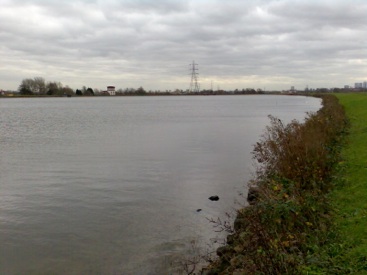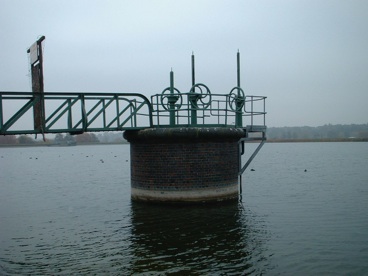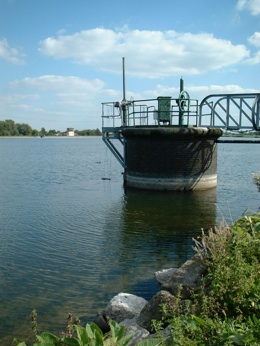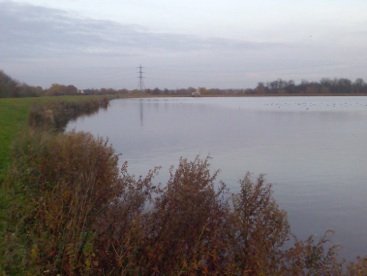East Warwick Background

A few years back our chairman concluded his last East Warwick report by saying “...if it wasn’t for the stance adopted by Walthamstow Fly-fisher’s Club years ago we would be looking at the East Warwick bird reserve, not the East Warwick catch & release trout fishery.” That’s how close we came to losing it.
Stocked with trout as early as 1980-82, the East Warwick had been used as a temporary fishery when Nos 4 or 5 had to be lowered for inspection purposes. Consequently, rising fish were occasionally seen by those making their way back from No 5, and a few had always fished it on the quiet with surprisingly good results.

Other good fish included 9lb browns (both returned) to Steve Marshall and Brian Jenkins in 1991. 1992 saw a stocking of 2,000 browns spread over No.5 and the Warwick, with another 2,000 browns going into all three reservoirs in 1993. With a proven record of growing fish on to provide superb fly-fishing, you might think the future of the Warwick was secure, but this was to change in 1996.
As a nationally important location for breeding wildfowl, Walthamstow is classed as a Site of Special Scientific Interest (SSSI). Because of this Thames Water operated under a Management Agreement with English Nature (now Natural England, and formerly the Nature Conservancy Council) for matters outside water supply operations.
After the usual rumours, a meeting in August 1996 revealed that, in reply to Thames Water’s request to lift the coarse fishing close season, English Nature had asked for half the West Warwick, half No 3 and half the East Warwick to be nature reserves. In turn, Thames had suggested closing the entire East Warwick to fishing.
The Thames Water management in charge at that time had recently been struggling to make fly-fishing pay—in our opinion through a combination of lax management, unco-operative staff and lack of qualified fisheries expertise. We suspected that their counter offer had been put forward simply as a convenient stop-gap solution acceptable only to Thames and English Nature.
We had also been told by the Farmoor club that Thames Water’s Recreation Manager had recently attempted to remove their long-standing lease to fish Farmoor 1 (a measure which actually took place at the end of 2006), and turn the place into a coarse fishery (now run as a big-fish catch & release water). So when he called a meeting between all parties the following September, we feared the worst.
As their own representative admitted, English Nature’s ideal solution would be to see the whole site closed to angling. However, the Recreation Manager reassured us that, on top of their own Code of Practice requiring Thames Water to make the most of recreational opportunities, under the 1991 Water Industry Act they were under a statutory and legal obligation ‘to provide recreation for land and water use...where practicable’.
Jolted into action by the removal of the close season, English Nature now had a national agenda to reach a Site Management Agreement on all the sites they were involved in by the year 2000. (Leading to them making extra demands—at Rutland, Grafham and other venues up and down the country.)

Concerned that the removal of the close season would not lead to a ‘net loss to wildlife at Walthamstow’, they saw the ‘key problem’ to be the ‘depressed breeding success of key species on the site’, claiming that the East Warwick had been the most important site for breeding wildfowl. We objected to anglers being held responsible for this apparent decline, particularly when higher numbers and greater breeding success coincided with a period which saw more anglers, not less.
(In fact, when the actual bird figures were examined, these were not as conclusive as English Nature had claimed. Their case was further undermined by a report in September 1998, observing that the East Warwick was one of the less important breeding sites, with tufted duck and pochard preferring the High Maynard. The presence of Canada Geese had the greatest effect, and control measures were discussed later in the year.)
If we did have to lose a reservoir to fishing (and we did not see why any should go), why should the fly-fishermen lose one and maybe two, when the coarse fishermen had seven underused reservoirs at their disposal? (Nos 1, 2, 3 and the West Warwick south of Ferry Lane, with the Low Maynard, the High Maynard and the Lockwood to the north.)
Thames Water’s Conservation Officer reported on a number of measures agreed with English Nature—without any previous consultation with anglers. (These included the ‘re-profiling’ of the island. £20,000 was spent on tree-removal and hollowing into a ‘scrape’, to encourage marginal vegetation more attractive to ducks and wading species. With limited success, we would suggest.)
In October 1996, with the personal support of Chris Poupard, then chairman of the Salmon and Trout Association, we made it clear we would be willing to negotiate on certain points if this meant not losing fly-fishing on the Warwick. Thames Water might not be able to stock three reservoirs to a normal level, but it was already clear the East Warwick could get by on a light stocking, with a light level of fishing pressure. Other areas we were prepared to compromise on included reserved areas and a close season.
In September 1997 we signed the first of a series of annual agreements between the club and Thames Water whereby club members could fish the reservoir on a catch & release basis at no extra charge. No more than 20 could fish at any one time (never a practical problem); fishing would not be allowed from most of the West bank; and there would be a close season from June-August inclusive (the time, we were advised, which was considered most important for breeding birds). As anyone who was fishing the water then will know, there was an ample residual stock left in the water after 1996, with a further 900 fish going in during 1997.

After a couple of seasons, Thames wanted to produce some identifiable income from the East Warwick, which led to the introduction of a £20 season ticket in September 1999, with the revenue used to offset the cost of stocking. Poaching rumours may have kept visits down, but towards the back-end, Roy Fox, Tony Fox and Andrew Smith were averaging over 7 fish a trip with rainbows up to 9-10lbs.
Just as we were looking forward to more good fishing, we had a major setback following a police investigation into a carp stealing racket by Thames Water staff, which led to the wholesale dismissal of most of the gate office personnel, including their immediate manager. This disrupted stocking plans for the April 2000 opening of the day ticket reservoirs, attracting more bad publicity. No fish were stocked, but in an attempt to repair the damage, you were allowed to fish 4 and 5 on a winter ticket, and the East Warwick if you’d renewed your £20 season ticket.
This may have been a low point but meetings with Steve Symonds, the new Amenities Manager and a qualified fisheries expert, were promising. Although we had not yet seen a stocking in 2000, up until the end of September trout fishing was available on 4, 5 and the East Warwick (for club members—outside the June-August close season) at £9.50 and then £6 a day.

During this time, the present self-service system was introduced, one of the measures which gave Walthamstow at least the appearance of a properly run fishery, and which, together with proper season tickets on Nos 4 and 5, had been badly needed for years.
In March 2001, Thames increased the price of the East Warwick season ticket to £65, with the aim of making the fishery self-financing. This coincided with an extra stocking of a further 250 rainbows and 65 browns. Despite this, the initial uptake of the £65 ticket was slow, with just 5 or 6 members coming on board. Once reports began to filter out about the kind of fishing available, though, people were quick to sign up.
Later meetings with Symonds’ number two, Damien Wood, identified that, at a proposed stocking level of 400-500 2lb trout a year, we needed an East Warwick membership of around 20 to achieve this. At the time, our EW membership stood at over 30, so we appeared to have comfortably reached our target. In addition to regular, closely monitored, stocking and, at its best, some brilliant fly-fishing, we had also gained access to the whole of the West bank.
The latest development is that Thames wish to increase the income they derive from the East Warwick, so that the price of EW season tickets will rise from the present £80 (still a good deal considering you’ve got until the end of May to use it) to £180 (but just £100 if you already hold a Nos 4 & 5 season ticket). In return, they will increase stocking levels from the previous 400-500 1kg trout a year, to 600 rainbows and 250 browns. They backed this with a stocking of exactly these numbers of trout in August last year, and these are the fish that are now providing our silver 3lb average fish.
Make no mistake, the good fish are still in there (see the record sheets and our East Warwick Gallery>>). This is a catch & release fishery so with luck those fish, especially the browns, are still in there to be caught. In the days when the water was infrequently stocked, you might have to put up with a few blanks in between catching – but when you did catch it was often a good one. Now we have a few 3lb fish to keep the interest going while you stick it out for the big ones.
